Mart review: Exchange rates support livestock trade
Currency has been king this year, with prime lamb, prime beef and dairy cattle prices all underpinned by a weak pound.
Lamb has perhaps been the biggest beneficiary of €1 being worth 80-85p for much of the year as heavier lambs have sold well.
At its peak, €1 rose to 93p in August, coinciding with the late summer glut of lambs. Meanwhile, the exchange rates have left Irish and Polish beef and European dairy cattle looking unattractive to some traders.
See also: Livestock farmers panic-buy straw as prices soar
Prime lamb prospers
Export demand, driven by a weak pound, has removed a lot of the troughs from trade at Sedgemoor and underpinned very good lamb prices this year.
And, with the pound still weak and exports strong, there is no reason to suggest things will change, explains sheep auctioneer Paul Ashton of Greenslade Taylor Hunt.
“Up to Brexit prospects are favourable,” says Mr Ashton. “Exports are driving trade and a weaker pound is the principal factor at play.
“Trade has been ahead of last year most of the way through and the return has perhaps been there to justify feeding a bit more concentrate in the autumn. We have been at 160-170p/kg for a long time, we didn’t see the usual August-September drop.”
However, it hasn’t been a straightforward year, with many farms seeing a rise in lameness issues and early lambers still not being fully rewarded for their efforts.
“Spring prices are still not high enough, probably for the third year running,” he explains. “Early lambs were £100 a piece but so were lambs in June.”
Worth the weight
A similar story has been seen at Melton Mowbray, where auctioneer Tom Greenhow says extra weight (46-48kg) has been worth hitting, with heavier lambs matching the handier weights (40-43kg) for price per kilo.
He says the summer highs (SQQ averages of 240-250p/kg) prompted people to cash in lambs earlier and at lighter weights.
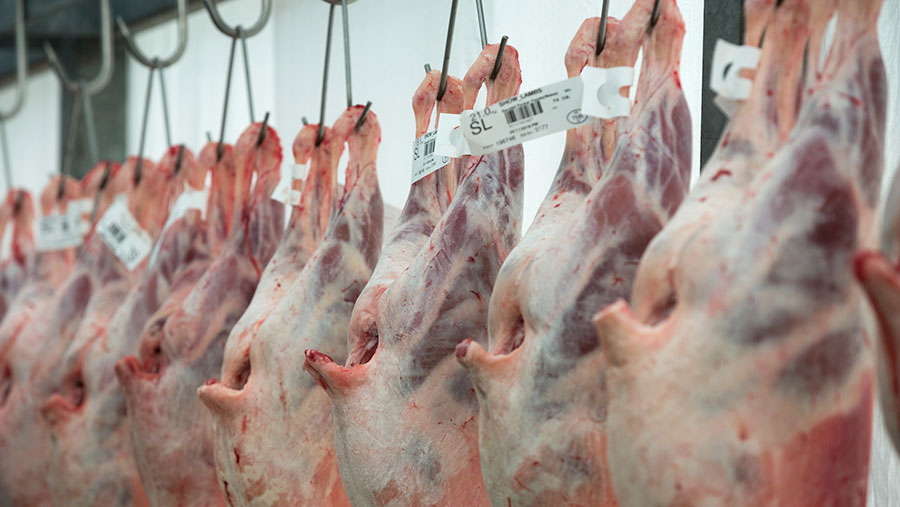
Heavier lambs at 45kg or more were rewarded this year © Tim Scrivener
This has allowed room for a “fantastic” store lamb trade, which was also been helped by good winter crop growth and autumn grass for his buyers.
“People are also perhaps quite confident in abattoirs wanting new-year lambs at the moment,” says Mr Greenhow. “A weak pound always helps sell lamb.
“Cull ewe trade has faltered here and at a lot of marts over the past couple of months, although lighter ewes held up as buyers wanted stock to put on grass.”
Selective but solid breeding ewes
Early mule lamb sales opened strongly. Prices at Hawes, Skipton, Builth Wells and Bentham all saw lambs about the £98-£102 mark.
However, as the season wore on many saleyards saw sheep become harder to sell, particularly second and third-quality entries.
This was certainly the case at Builth where Chris Davies of Brightwells reported shearlings up £16 a head to £150.82 but ewe lambs back 40p to £101.15.
“It paid to get stock looking well for sale,” explains Mr Davies. “Running lambs were harder to sell and were back on last year. Hill breeds like the Beulah and Welsh Mountain were difficult to sell as well.”
Many marts have continued to find it hard marketing the light hill lambs, which Mr Davies says is probably his biggest problem.
“Lambs below 30kg have been at 130-140p/kg this autumn and improved slightly more recently to 150p/kg but there isn’t much of a market for them. The price of skins is back, which isn’t going to help.
“My advice for farms selling live is to monitor exchange rates and follow the Muslim calendar. Ask about when Eid and Ramadan are as this was putting £10 a head on lambs, it creates massive demand.”
A strong lamb cheque gave sheep breeders 2016 prices at Cockermouth’s Lakeland Livestock Centre, where John Wharton of Mitchells has seen sheep farms benefit from having cashflow this year.
Continental-crossed shearlings hit the £128-£132 mark and North of England Mule sales still saw prices hitting £133 and two shears to £130.
“Of the mules the smaller running lambs were about £86-£90 and the tupping lambs were about the £95 mark, with some getting up to £104, £105,” says Mr Wharton
“Our Swaledales were back, following the trend across Northern England. Herdwick drafts were up £5 to £56. Cockermouth is one of the few places you can buy them.”
Firm dairy trade
Heifer rearing costs, TB culling and some herd expansion have maintained demand for heifers. Non-aligned prices overtook aligned contracts in October when Defra’s UK all-milk price rose 4% to 31.61p/litre in October.
Dairy cattle prices are “firm but not on fire”, says Fred Spurgeon of Richard Turner and Sons at Gisburn, where fresh cow and heifer supply is at a good level to meet demand.
The peak in the year came in September and October, where a rush to secure autumn milk yielded more £2,000-£2,200 price tags for commercial pedigree heifer across the marts.
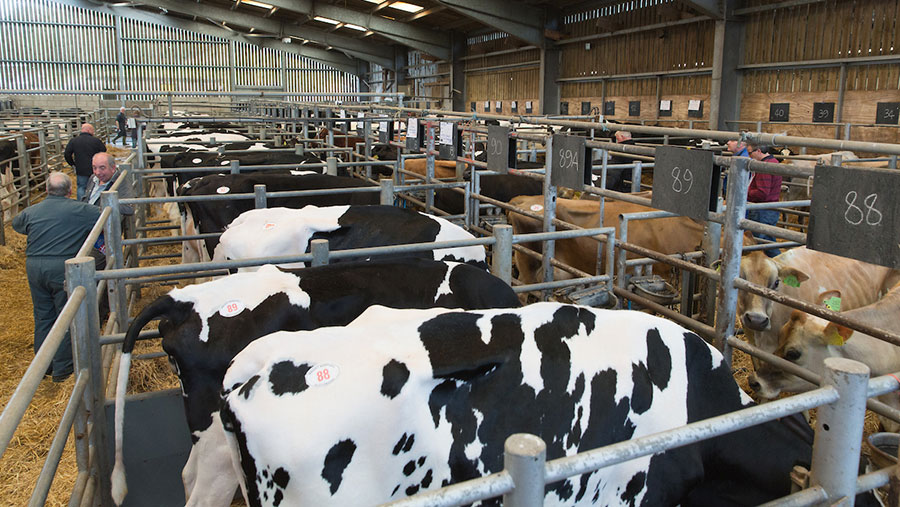
Autumn brought the highlights of the commercial cattle, with prices back about £100 since then © Tim Scrivener
“People were trying to lift profiles and get into the next volume band but since then the £2,000 heifers aren’t impossible but more of an exception,” says Mr Spurgeon. “I don’t think anything for sale in the spring is going to be too popular next year.”
Mr Spurgeon adds that plain cull cows making 85-90p/kg and beef-cross calves hitting £300-£400 make rearing heifers look unattractive.
Since the autumn highs, heifer prices have tailed off into the winter, with Simon Lamb of Wright Marshall noting trade back £100 a head.
But despite the snow Beeston Castle saw 28 lots pass the £2,000 mark and five at £2,300 or more at its December mid-month sale.
“Exchange rates have helped cattle prices,” explains Mr Lamb. “Foreign heifers have been more expensive.”
And with milk price cuts beginning and many farms short of feed, Mr Lamb sees a difficult winter ahead for many in the industry.
“Lots of clients in the North West are short of feed,” says Mr Lamb. “I have one customer with 500 cows who has done one cut of silage.
“People on aligned contracts could see their milk go up because of the price of straw and fuel. Their prices are higher.”
Good year for prime beef
Gavin Paterson of Craig Wilson which runs Ayr and Newton Stewart markets says currency has restricted Polish and Irish beef entering the UK market.
This has supported the prime market but store cattle have been more difficult to call, with poor weather making grazing cattle very tough and leaving silage stocks in short supply.
“Prime cattle have been ahead of last year,” says Mr Paterson. “There’s not been an abundance of prime cattle anywhere in the UK so that has helped prices too.
“Grazing cattle haven’t done nearly as well this year because of the wet weather from July to November and as a result people mainly want short-keep cattle. Strong stores around 470-480kg are in demand.”
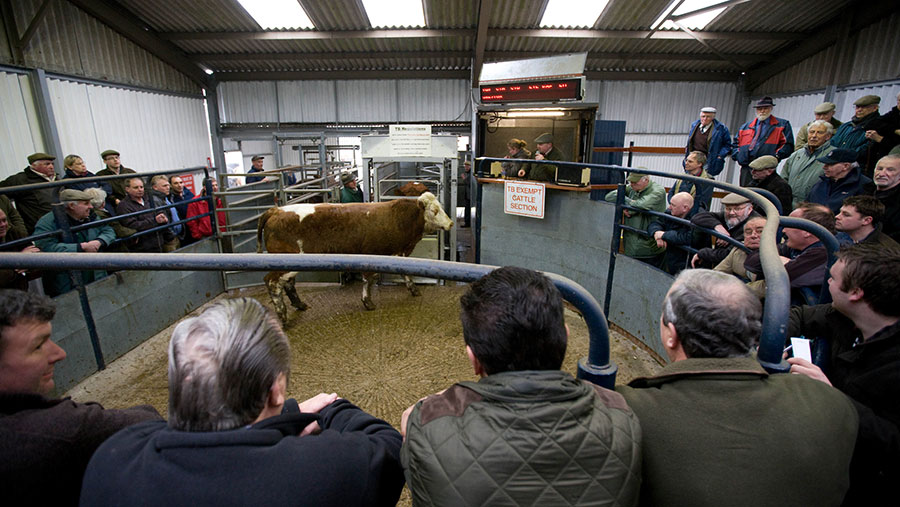
Prime cattle prices have been ahead of last year but stores have been a more mixed picture © Tim Scrivener
A similar story was had for the light suckled calves (240kg). Then, at Newton Stewart’s two-day store-cattle sale, strong cattle were dearer but overall trade was back £12 a head.
A very good year’s trading has surpassed expectations at Rugby mart for auctioneer Tom Wrench, where overall throughput is up 35% and nearly 4,000 lambs is becoming a regular weekly figure.
Spring beef trade held up well compared with 2016. Deadweight prices strengthened in May to a September high of 375p/kg. More recently, deadweight prices in the Midlands have hovered at 345p/kg.
“We’ve not had the big drops this year, it’s been a smoother curve,” says Mr Wrench. “A weaker pound has helped sell cattle.
“What we miss in the Midlands, as opposed to northern England, is the quantity of butchers at the ringside, buying their own.
“However, these butchers have perhaps helped keep trade steady at times with their reliable orders of five to 10 animals a week. Their customers aren’t as price sensitive as the supermarkets perhaps are.”
2017 top prices
Sheep: £10,000
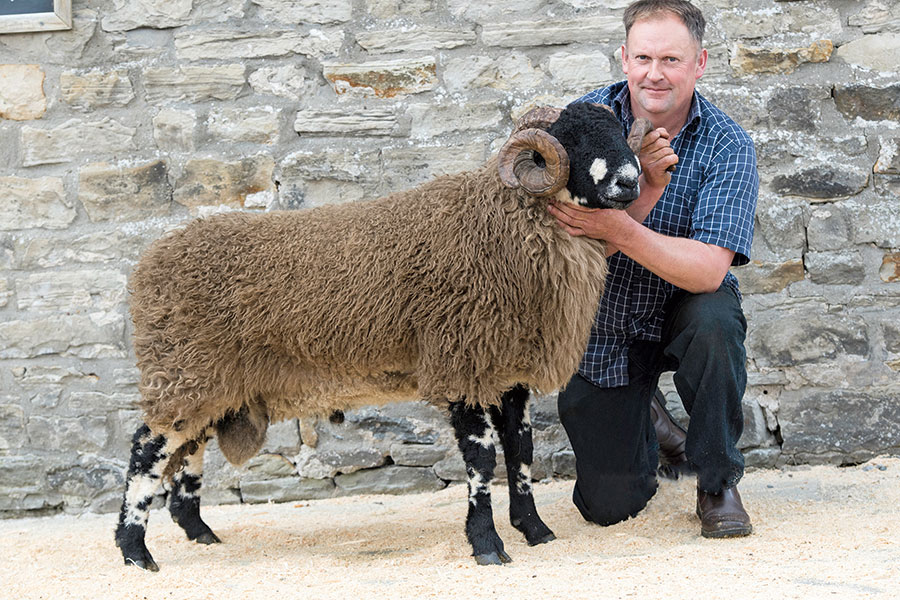
© Wayne Hutchinson
Dalesbred records were broken at Bentham when a shearling from Messrs M Taylor and Son, Higher Brayshaw, Tosside earned a £10,000 two-way bid from Frank Brennand, Ellerbeck, and John Dawson, Lancaster. The sire was by a John Harrison tup, Bluberrhouses, and out of a Penyghent ewe.
Beef: 11,000gns
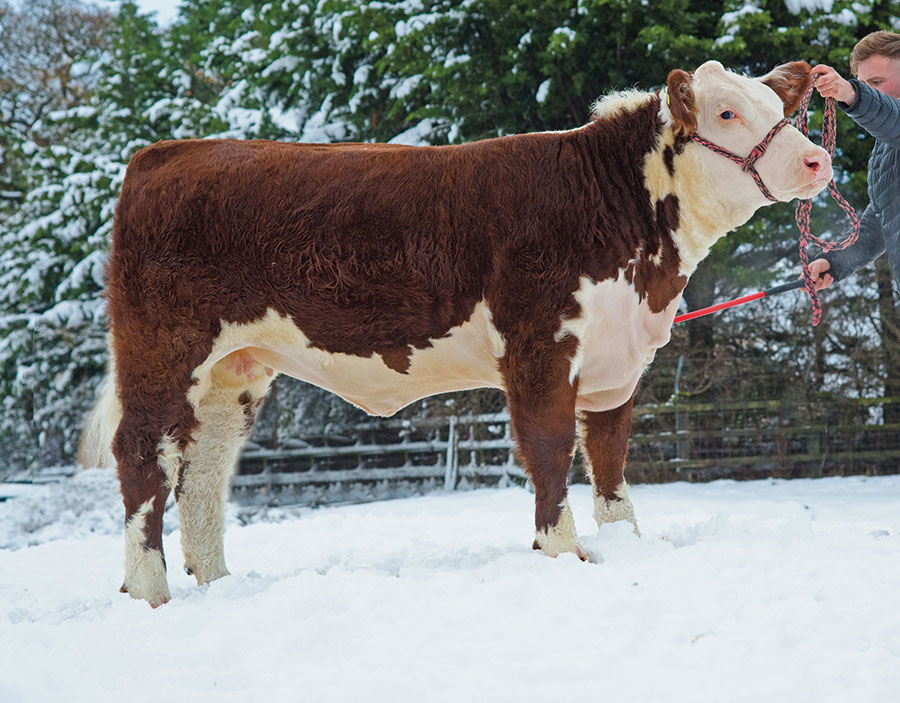
© John Eveson
Hereford cattle again made headlines at the second Designer Genes sale at Shrewbury, with a monster call of 11,000gns to set a new breed heifer record. The 16-month-old heifer Sky High 1 Lâncome Lucy from B Birch & G Brindley sold to Gouldingpoll Herefords and Intelagri, Ireland.
Sheep: 27,000gns
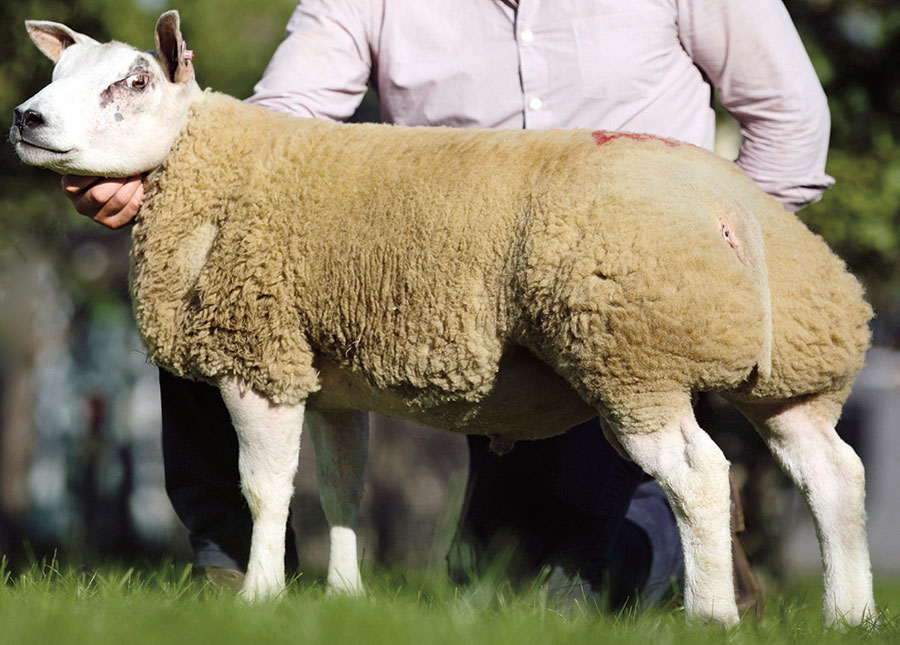
© Catherine MacGregor
The Beltex ram lamb record was broken for the second year running at Borderway by Richard Wood, Tweedsmuir, Biggar, who saw a 27,000gns bid from W and A McCrabbe, Raphoe, County Donegal. Kingledors Crusader is by Glantre Armani and out of a Viagrow V/d Drie Musschen ewe.
Beef: 24,0000gns

© Wayne Hutchinson
A record 24,000gns British Blue bull bid was reported at Borderway when Dragon Blues Kai knocked down to TE Jones and Co, Bailea Farm, Sennybridge, Powys. The two-year-old is from GW and K Williams, Llanwnnen, Lampeter, and by Tweeddale Hebony and out of Dragon Blues Gweno.
Sheep: 25,000gns
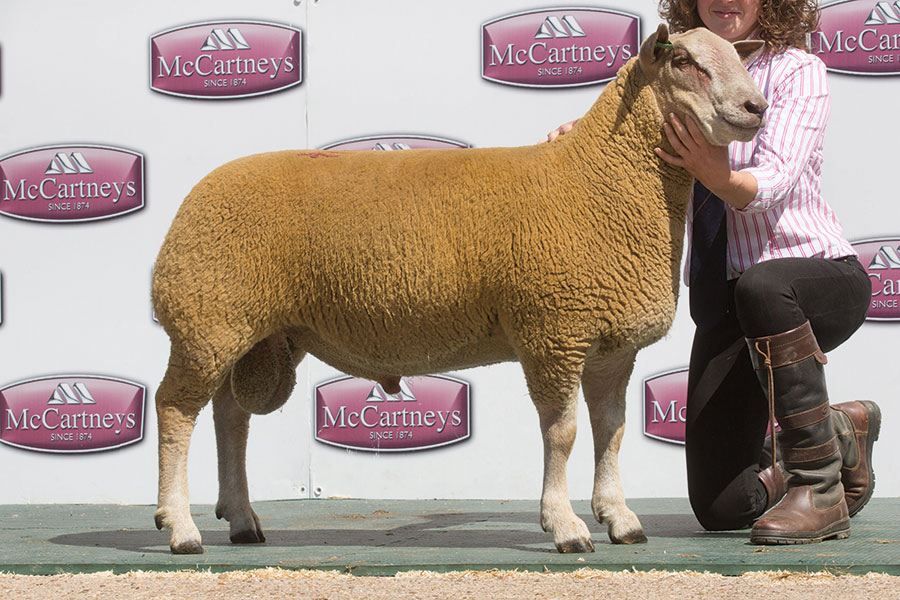
© Tim Scrivener
Charollais ram Knockin Shockin from Abbie Moseley, Knockin, Shropshire, set a new breed record of 25,000gns when knocked down to Shropshire breeder Robert Gregory at Worcester. He is by Oakchurch Ruben and out of a Dalby Malachite ewe.
